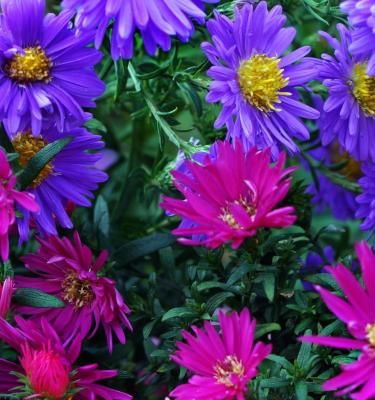

How to grow and care for Aster
Aster (Callistephus chinensis) or Chinese Aster are fast-growing, flowering annuals that thrive in the warmth of spring, summer and continue blooming into autumn. Asters come in a range of colours including; white, pale yellow, pink, mauve, burgandy and purple. You’ll also find varieties of aster with double pom pom-like flowers and other varieties with a single row of petals and an open centre.
Asters grow around 40-60cm tall and they’re typically used to fill the middle section of flowering borders, but they also look amazing in potted displays. Grow asters for a bright pop of colour where you need it and they’ll also bring in the beneficial insects to control pests and bees to aid pollination.
With long, sturdy stems, asters also make a great cut flower that lasts well in a vase so you can enjoy them indoors too.
Top 5 steps to growing aster
- Choose a full sun spot with a moist, but free draining soil to grow asters.
- Enrich the soil before planting with plenty of compost, like Scotts Osmocote Compost Premium Soil Improver.
- Cut off spent flower heads to encourage more blooms to follow and encourage a bushy plant.
- Fertilise with Scotts Osmocote All Purpose Controlled Release Fertiliser at planting and Scotts Osmocote Pour+Feed for Flowering Plants throughout the growing season
- Aster can also be grown in pots, look out for compact varieties best suited to growing in containers and smaller spaces.
Shopping List
- Aster seedlings or seeds
- Scotts Osmocote All Purpose Controlled Release Fertiliser
- Scotts Osmocote Pour+Feed for Flowering Plants
- Scotts Osmocote Compost Premium Soil Improver
- Garden trowel or shovel
- Mulch
- Defender Snail & Slug Pellets
- If growing in pots, you’ll need Scotts Osmocote Premium Potting Mix + Scotts Osmocote Pour+Feed for Flowering Plants and a suitable pot or container
Preparation & Planting in the garden
Asters prefer a full sun spot in a well drained and rich soil. Prepare the site for planting by mixing Scotts Osmocote Compost Premium Soil Improver through the original soil - using a garden shovel to turn it through the top 10-20cm.
Gently remove the aster seedling or plant from the nursery punnet or pot and tease the roots lightly if they are compact.
Plant your aster into the prepared soil and backfill around each. Always follow the labels direction for spacing aster plants or seedlings as some spread out more than others. Water in well and mulch to suppress weeds and retain moisture.
How to grow aster flowers from seeds
Aster seeds are best sown in trays or punnets filled with Scotts Osmocote Seed Raising Mix and transplanted into the garden when they are big enough.
Fill punnets or trays with seed raising mix sow aster seeds 6mm deep and keep them moist until they germinate in 10-15 days. Aster seeds will germinate best when the soil temperature is 20-25 degrees Celsius so use a heat mat or glasshouse if needed.
Once your aster seedlings have 2 sets of true leaves and are big enough to handle, they can be separated into individual plants and transplanted in your garden or larger pots to continue growing.
Mulch around new seedlings to suppress weeds and retain moisture. If needed protect young seedlings from snails and slugs with a sprinkle of Defender Snail & Slug Pellets around each plant.
Planting in pots
Aster can be successfully grown in pots with good drainage - choose a pot to suit the mature height and width of your chosen variety. If you’re limited on space look for the compact aster varieties with a shorter growth habit.
Fill your pot or planter with Scotts Osmocote Premium Potting Mix. Gently remove the aster from the nursery pot and tease the roots lightly if they are compact or separate the plants if they are growing in punnets. Plant the aster into the potting mix and backfill around each plant. Water in well and top the soil with mulch to retain moisture.
Fertilising & Care
Aster will benefit from an application of Scotts Osmocote All Purpose Controlled Release Fertiliser at planting time and a fortnightly dose of Scotts Osmocote Pour+Feed for Flowering Plants during the growing season will help promote more blooms.
Deadhead your asters to remove spent flowers and encourage new blooms and a bushy growth habit. Really tall varieties may need staking or support netting to prevent them from falling over.
Pests & Diseases
Slugs and Snails can cause significant damage to young aster seedlings. Protect young plants by setting beer traps (saucers filled with beer) amongst seedlings or use Defender Snail & Slug Pellets.
Avoid overhead watering that wets the foliage of your aster plants as this can encourage fungal diseases like Powdery Mildew. If you notice any Powdery Mildew or fungal diseases remove any infected foliage immediately and improve the airflow around your plants to reduce the risk of further outbreaks.



